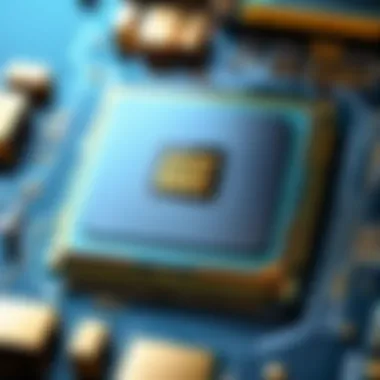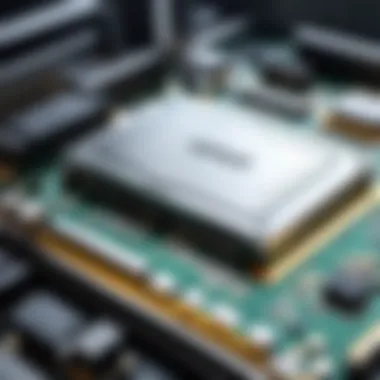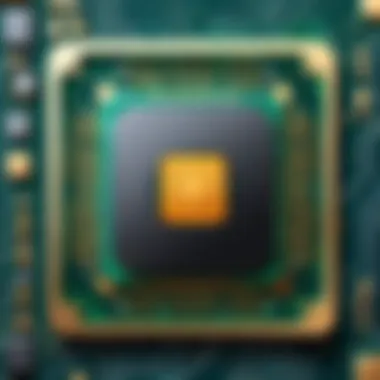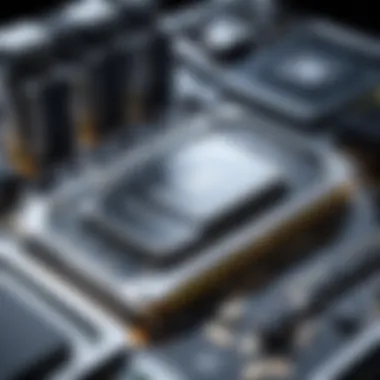Unveiling the Distinctions: CPU vs GPU Comparison for Optimal Performance


Product Overview
In the world of computer hardware, the comparison between central processing units (CPUs) and graphics processing units (GPUs) is a topic of great relevance. CPUs, often referred to as the brain 🧠 of the computer, are known for their versatility in handling various tasks like browsing the web, word processing, and multitasking. On the other hand, GPUs, known as the visual powerhouse 💻, excel in graphics rendering, video editing, and gaming, thanks to their parallel processing capabilities. Understanding the distinctions between CPUs and GPUs is paramount for tech enthusiasts, gamers, and IT professionals seeking to optimize computing performance and efficiency.
Performance Comparison
When analyzing CPU vs GPU performance, benchmark tests play a crucial role in determining speed and efficiency. CPUs are proficient in handling sequential tasks, making them ideal for activities that require intricate processing like coding or spreadsheets. On the contrary, GPUs shine in parallel processing, enabling seamless rendering of complex graphics in video games or demanding visual design applications. By examining benchmark tests and speed comparisons, individuals can make informed decisions on which hardware suits their specific computing needs.
Features and Technology
Looking at the features and technology of CPUs and GPUs reveals their unique advancements and compatibility. CPUs boast features like cache memory and onboard graphics, enhancing overall system responsiveness and visual output. In contrast, GPUs leverage advanced technologies such as CUDA cores and ray tracing to accelerate graphics processing and deliver lifelike visuals in gaming and 3D design. Understanding the compatibility of CPUs and GPUs with other devices is pivotal in building a system tailored to one's requirements.
Pros and Cons
Assessing the strengths and weaknesses of CPUs and GPUs is essential for a holistic perspective. CPUs offer strengths in general-purpose computing, ensuring reliability and compatibility across a wide range of software applications. Nonetheless, CPUs face limitations in high-demand graphical tasks due to their sequential processing nature. On the other hand, GPUs excel in parallel tasks and graphic-intensive activities but may lack optimization for non-graphical workloads. Identifying the pros and cons of CPUs and GPUs aids users in maximizing performance while mitigating potential limitations.
Value for Money
Evaluating the cost-effectiveness and long-term benefits of CPUs and GPUs is crucial for determining the value proposition. CPUs typically come at a lower initial cost compared to GPUs, making them accessible for budget-conscious consumers. However, GPUs offer substantial long-term benefits in optimized graphical performance and enhanced visual experiences, especially for gaming enthusiasts and creatives. Comparing the value for money between CPUs and GPUs involves assessing both short-term affordability and long-term performance gains to make an informed investment decision.
Introduction


In the fast-paced world of computer hardware, the comparison between Central Processing Units (CPUs) and Graphics Processing Units (GPUs) holds immense significance. Understanding the fundamental variances between these two crucial components is vital for professionals in the tech industry, gamers, and IT enthusiasts. CPUs act as the brains of a system, executing instructions and performing calculations for overall system operation. On the other hand, GPUs specialize in rendering graphics-intensive tasks, excelling in parallel processing tasks suited for gaming and visual-heavy applications. By unraveling the complexities of CPUs and GPUs, individuals can harness the unique advantages of these processing units across different computing scenarios. This exploration will shed light on the distinctive functionalities, architectural variances, and performance benefits embedded within CPUs and GPUs, ultimately revealing how these elements shape the realm of computer technology.
Understanding CPU and GPU
In the realm of computer hardware, the understanding of Central Processing Units (CPUs) and Graphics Processing Units (GPUs) holds immense significance. These components play crucial roles in the processing and rendering of data, each with its specific functions, benefits, and considerations. The CPU serves as the brain of a computer, handling the majority of instructions and calculations for various tasks. On the other hand, GPUs are specialized processors designed to handle complex graphical and parallel computing tasks efficiently. Understanding the differences between CPUs and GPUs is essential for optimizing performance and efficiency in computing systems.
Defining CPU
A Central Processing Unit (CPU) is a hardware component responsible for executing instructions from computer programs. Acting as the primary control unit of a computer, the CPU performs arithmetic, logic, control, and inputoutput operations specified by the instructions. CPUs consist of cores that enable multitasking and parallel processing, allowing for swift data manipulation and computation. The architecture of a CPU includes components such as registers, cache memory, arithmetic logic units, and control units, all working together harmoniously to ensure seamless operation.
Exploring GPU
In contrast to CPUs, Graphics Processing Units (GPUs) are specialized chips primarily focused on accelerating the rendering of images and videos. GPUs are optimized for performing repetitive tasks required for graphics rendering, making them ideal for gaming, graphic design, and scientific simulations. These processors contain a vast number of cores specifically designed for parallel processing, allowing them to handle multiple tasks simultaneously. The architecture of a GPU includes components like streaming multiprocessors, texture mapping units, and memory buffers, tailored to enhance graphical processing speed and efficiency.
Differentiating CPU and GPU
While both CPUs and GPUs are essential components of modern computing systems, they differ significantly in their functionalities and applications. CPUs excel at sequential processing and general-purpose computing tasks, making them suitable for a wide range of applications such as web browsing, office work, and everyday computing needs. On the other hand, GPUs thrive in parallel processing and are highly efficient in handling tasks that require immense computational power, like 3D rendering, machine learning, and cryptocurrency mining. Understanding the distinctions between CPUs and GPUs is crucial for selecting the appropriate hardware based on specific computing requirements and desired performance outcomes.
Functionality and Architecture
In delving into the realm of CPUs 🧠 and GPUs 💻, one cannot overlook the fundamental aspect of functionality and architecture. This elucidates how these processing units operate and are structured, playing a pivotal role in their performance and efficiency. The functionality of a CPU primarily revolves around executing instructions and managing tasks at the core level of a system. On the other hand, the architecture of a GPU is optimized for parallel processing, ideal for handling complex graphical computations efficiently. Understanding the distinct functionalities and architectures of CPUs and GPUs is crucial for harnessing their full potential in diverse computing tasks.
CPU Functionality


The core functionality of a CPU lies in its ability to carry out a wide range of tasks within a computer system. From executing instructions, performing arithmetic operations, to managing memory access, the CPU acts as the brain of the system. Its high clock speeds and multiple cores enable it to handle sequential tasks effectively, making it suitable for tasks that require quick decision-making and processing of complex algorithms. Additionally, features like cache memory and pipelining enhance its performance, contributing to swift task execution. By comprehending the intricate functionality of CPUs, users can leverage their capabilities optimally in various computing applications.
GPU Architecture
In contrast to CPUs, GPUs are designed with a specialized architecture tailored for graphics-intensive tasks. The architecture of a GPU comprises numerous cores that work in parallel to process a vast amount of data concurrently. This parallel processing capability allows GPUs to excel in rendering complex visual elements, such as images and videos, with remarkable speed and efficiency. Moreover, GPU architectures are optimized for handling matrix operations and floating-point calculations, making them highly efficient for tasks related to graphics rendering and scientific computations. By grasping the unique architectural features of GPUs, users can harness their processing power for applications requiring intensive graphical processing and parallel computations.
Performance and Efficiency
In the realm of computer hardware, understanding the intricacies of performance and efficiency is paramount for users seeking optimal functionality. When delving into the comparison between CPUs and GPUs, the aspects of performance and efficiency play a significant role in determining the suitable hardware for specific tasks. Performance refers to the speed and capability of a processor to execute tasks effectively, while efficiency pertains to how well the processor utilizes resources to achieve its goals. By analyzing these factors, users can make informed decisions regarding their hardware choices.
CPU Performance Metrics
CPU performance metrics serve as fundamental indicators of a processor's capabilities and effectiveness in handling tasks. Clock speed, instruction per cycle (IPC), cache memory, and core count are among the key metrics that characterize CPU performance. Clock speed dictates how quickly the CPU can process instructions, IPC measures the efficiency of each instruction execution, cache memory reduces data access latency, and core count determines the multitasking capacity of the processor. Understanding these metrics allows users to gauge the performance potential of a CPU accurately.
GPU Efficiency Factors
In the domain of GPUs, efficiency factors are critical in optimizing graphical processing tasks. GPU efficiency is influenced by factors such as core count, memory bandwidth, texture fill rate, and power consumption. Core count signifies the number of processing units within the GPU, memory bandwidth governs the data transfer speed to and from the GPU memory, texture fill rate determines the GPU's ability to handle textured objects, and power consumption indicates the energy efficiency of the GPU. Assessing these efficiency factors enables users to select a GPU that aligns with their graphical processing requirements.
Comparing Performance and Efficiency
When comparing CPU performance to GPU efficiency, it is essential to consider the nature of the tasks at hand. CPUs excel at sequential tasks that require high-speed processing of individual instructions, making them ideal for general computing and applications requiring complex algorithms. On the contrary, GPUs are designed for parallel processing, allowing them to handle numerous simple tasks simultaneously, which is advantageous for graphics rendering, scientific simulations, and deep learning applications. By juxtaposing the performance strengths of CPUs with the efficiency advantages of GPUs, users can discern the optimal hardware configuration based on their specific computing needs.
Applications and Use Cases


In the realm of computer hardware, a crucial aspect that demands meticulous consideration is the utilization and applications of CPUs 🧠 and GPUs 💻. Understanding the distinctive functionalities and benefits of these components is imperative for optimizing performance and efficiency in technology-driven tasks. CPUs are renowned for their exceptional ability to handle complex computational processes. They serve as the brain of a computing system, executing instructions and task sequences with precision and speed. On the other hand, GPUs are specialized processors designed for graphic-intensive operations. Their parallel architecture enables swift rendering of high-quality visuals, making them indispensable for tasks like gaming, video editing, and 3D modeling. Recognizing the unique strengths of CPUs and GPUs allows tech enthusiasts, gamers, and IT professionals to leverage their capabilities effectively, tailoring hardware choices to suit specific computing requirements.
CPU Utilization in Computing
Delving deeper into the realm of computing, the utilization of CPUs plays a pivotal role in determining system performance and responsiveness. CPUs are adept at handling a wide range of tasks, from simple computations to complex algorithms, making them versatile components in computing devices. With the evolution of multi-core processors, modern CPUs can concurrently execute multiple threads, enhancing efficiency and multitasking capabilities. Moreover, CPU optimizations such as cache memory management and instruction pipelining further elevate processing speeds, ensuring seamless operation in diverse computing environments. IT professionals and system architects keen on maximizing computing potential often focus on optimizing CPU utilization, fine-tuning configurations to deliver optimal performance across various applications and workloads.
GPU Applications in Graphics
In the realm of graphics processing, GPUs stand out as indispensable components, driving advancements in visual computing and digital content creation. GPUs excel in parallel processing, efficiently handling complex rendering tasks and shader computations crucial for generating lifelike visuals. Their utilization extends beyond gaming, finding applications in scientific simulations, artificial intelligence, and virtual reality. By offloading graphic-intensive workloads from CPUs, GPUs enhance system performance, enabling faster frame rates and smoother graphics rendering. Pioneering advancements in GPU architecture continue to push boundaries in graphical fidelity, empowering content creators and designers to realize their creative visions with unparalleled detail and realism.
Real-World Scenarios
Real-world scenarios serve as veritable testing grounds for understanding the practical implications of CPU and GPU functionalities. In scenarios requiring rapid data processing and multitasking capabilities, CPUs demonstrate their prowess by swiftly executing sequential tasks and critical computations. Conversely, in scenarios demanding immersive visual experiences and graphic processing, GPUs shine by delivering stunning graphics performance and visual enhancements. Consider a scenario where a gamer navigates a visually intricate virtual world - the CPU manages game logic and AI computations while the GPU handles rendering to provide a seamless and immersive gaming experience. Real-world applications showcase the symbiotic relationship between CPUs and GPUs, illustrating how their collaborative efforts cater to diverse computing needs with efficiency and precision.
Future Trends and Developments
In the realm of computer hardware, continually evolving advancements shape the landscape of technology. The future trends and developments play a vital role in driving innovation and progress in the field of CPUs and GPUs. Understanding these trends is essential for staying abreast of the latest technological breakthroughs. By delving into the anticipated advancements, tech enthusiasts, gamers, and IT professionals can gain insights into what to expect in the upcoming generation of hardware.
Advancements in CPU Technology
The constant quest for enhanced performance and efficiency drives the advancements in CPU technology. Engineers and developers strive to push the boundaries of processing power, seeking ways to optimize CPUs for various computing tasks. From multicore processors to improved cache systems, each advancement aims to deliver quicker computation speeds and better overall system responsiveness. The evolution of CPU architecture paves the way for smoother multitasking, faster data processing, and increased productivity for end-users.
Innovations in GPU Design
GPU design innovations focus on maximizing graphical performance and computational capabilities. With a primary focus on enhancing rendering speeds and supporting complex visual effects, advancements in GPU design result in improved image quality in gaming, multimedia, and professional applications. The integration of cutting-edge technologies like ray tracing and AI-driven processing signifies a shift towards realistic visuals and immersive experiences for users. Innovations in GPU design not only elevate gaming experiences but also bolster the efficiency of tasks requiring high-speed parallel processing.
Integration of CPU and GPU
The integration of CPU and GPU heralds a new era of computing synergy. By combining the strengths of both processors, system designers aim to create balanced configurations that leverage each component's unique capabilities. This integration leads to optimized performance for tasks that demand both high computational power and parallel processing efficiency. The collaboration between CPU and GPU opens doors to new possibilities in artificial intelligence, scientific simulations, and content creation. As technology progresses, seamless integration between CPU and GPU is poised to revolutionize the way we interact with and benefit from computational devices.







